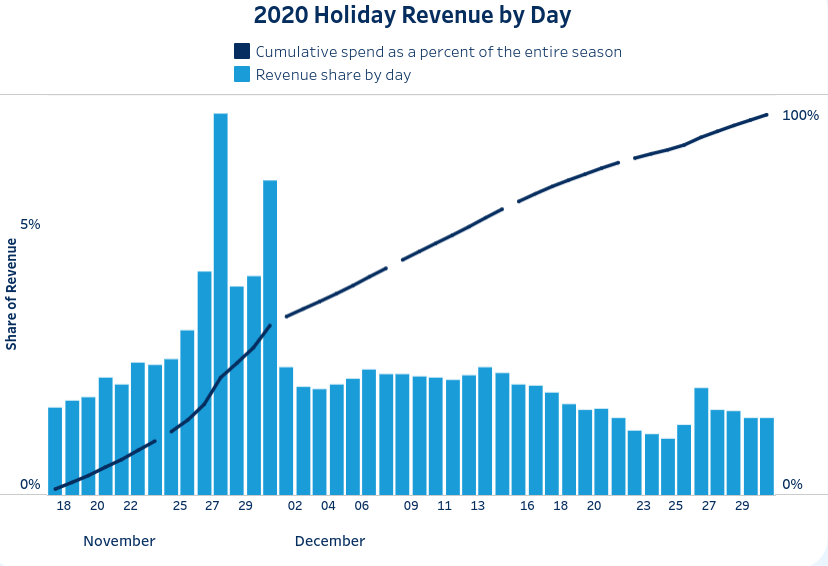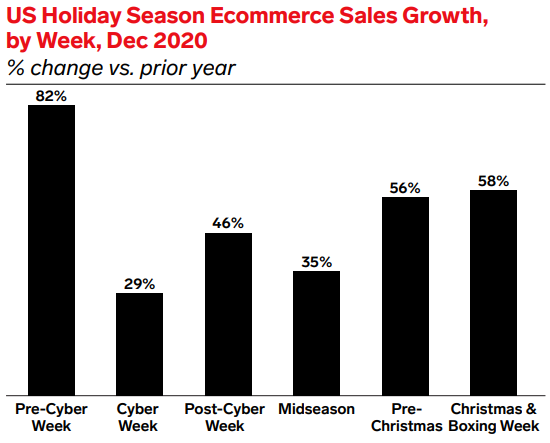The global pandemic caused a massive shift in consumer behavior in 2020. With fears of sickness and health spreading, ecommerce shopping and at-home delivery saw a sudden and sustained increase in demand. And yet, despite a tumultuous year filled with upended business models, total retail sales during the 2020 holiday season rose 6.5% over the previous year.
As the Delta variant of the Coronavirus reinforces those consumer behaviors of staying at home, online shopping and generally avoiding public spaces, we can expect to see the trends experienced in 2020 continue into the 2021 holiday season. And because online businesses and retailers have now had a year’s worth of experience under their belts, we further expect to see more advanced marketing techniques to capitalize on these demands.
In this article, we’ll explore the consumer trends for the holiday season from 2020, make some predictions for shopping behavior in 2021, and review the most important things to keep in mind when creating a marketing plan for the upcoming holiday season.
2020 Holiday Season Was Huge for Ecommerce

Source: Salesforce
The holiday shopping season in 2020 experienced an unexpected increase in overall sales. Despite some statewide shutdowns and health considerations dampening the public’s eagerness to go shopping in person, total spending in the retail sector was up 6.5% during the holiday season to $1.064 trillion.
Of that total, brick-and-mortar sales grew 2.2% to $878.26 billion, while ecommerce sales increased from 32.5% to $185.88 billion. That paints a pretty clear picture of what shopping trends to expect in the future, especially if statewide shutdowns and mask mandates continue to be commonplace.
“In 2020, global holiday digital sales topped $1.1 trillion. 45% of all digital holiday spend happened by the end of Cyber Week.”

Source: Insider Intelligence
2021 Is Predicted To Be Even Bigger
According to a study by Intelligence Insider, the market forces that shaped the 2020 holiday shopping behaviors are expected to continue into 2021. Brick-and-mortar stores may continue to grow at a slow pace, but consumers are expected to further push online sales to new heights in the upcoming holiday season.
“We expect 2021 holiday retail sales to rise 2.7% to $1.093 trillion, with brick-and-mortar increasing 0.9% to $885.99 billion and ecommerce climbing 11.3% to $206.88 billion.”
We would also expect to see a continuation of consumer behaviors that emphasize curbside pick-up or ship to store services.

Source: Insider Intelligence
Shifting Consumer Behaviors
According to a survey by Google, there is a strong desire to head back in-store this year. 85% of holiday shoppers indicate that they plan to return to brick-and-mortar stores in some way. And yet, despite this reported desire for physical locations, 58% of holiday shoppers report that they plan on doing more online shopping than in previous years.
What does this mean? There’s a growing desire to go back to the way things were before the pandemic, but consumers are still likely to increase their online holiday shopping behavior. The convenience of ecommerce shopping appears to be driving more marketing growth.
How to Prepare Your Marketing for the Holiday Season
Mark Key Dates In Your Marketing Calendar
Make sure that your marketing portfolio is prepped and ready to capitalize on spikes in consumer interest. Flash sales, email marketing, affiliate coupons, social media promotions, etc. Your announcements and marketing language should be prepped and ready to go for the following dates:
November:
Diwali (11/4)
Singles’ Day (11/11)
Thanksgiving (11/25)
Black Friday (11/26)
Small Business Saturday (11/27)
Hanukkah (11/28 – 12/6)
Cyber Monday (11/29)
December:
Last shipping day (12/21-12/22)
Christmas (12/25)
Kwanzaa (12/26 – 1/1)
Boxing Day / Post-season (12/26-12/31)
January:
New Years’ Day (1/1)
January sales (1/1-1/31)
Budget Time and Money for the Holidays
It’s standard practice among retailers and online advertisers to plan ahead for a spike in Q4 spending. But when and how much of that marketing budget to prepare for is the question.
According to Google, 45% of all digital holiday spending happened by the end of Cyber week. So we recommend that your online marketing budget focuses a proportional amount, (with at least 30% headroom), for the weeks leading up to the end of November. For big events like Black Friday and Cyber Week, we suggest a short, sudden burst of spending on search, shopping and display ads around 500% your normal spending levels.
In Nov-Dec 2020, global digital revenue from e-commerce saw a year-over-year growth of over 50%. And that trend is expected to continue upwards for 2021. We recommend taking a look at your business’ historical spending levels for the holiday season from past years, and extrapolating the expected growth in demand, structuring your marketing budget to anticipate these spikes in shopping behavior.
Google’s Recommendations for Holiday Advertising
Audit Your Website’s Performance Tracking
Before making any changes to your budgets or capitalizing on the expected increase in holiday shopping, we recommend performing a quick audit of your performance tracking settings. This will make sure that the performance data that your marketing mix relies on is as precise as possible.
- Assign conversion value to all conversions – For e-commerce businesses, make sure that your data layers are functioning correctly and display the correct conversion value for any individual product sale. For online businesses that rely on more nebulous conversions such as contact form submissions or calls to the office, refer to this guide on estimating conversion values. With a specified conversion value for every goal, your online advertising can take advantage of smart bidding strategies and optimize your marketing budget.
- Remove old goal conversions – Many Google Ads accounts that have been active for a few years will start to build up a large list of tracked goal conversions. Even if your campaigns do not include some of these conversions as goals, they may still confuse the machine learning algorithms for Smart Bidding strategies. Consider removing any goal conversions that are outdated or irrelevant for your active campaigns.
- Implement Google Analytics 4 – As of Q3 2021, Google is still beta testing the next generation of GA, called Google Analytics 4. This will eventually become the standard for web analytics, and looking into the future, historical data will be essential to optimizing your website and marketing in 2022. You can add GA4 to a site that already has Analytics to continue tracking your current performance while collecting next gen data in the meantime.
Google Merchant Center Settings
If your business runs on e-commerce, or your Google Ads accounts rely on Shopping or Product Search ads, it is absolutely essential to make sure that your Google Merchant Center settings are up to date and optimized for success.
- Diagnostics – In your Merchant Center account, check the “Diagnostics” section to troubleshoot any account issues, feed issues or item issues. Google provides individual errors and warnings that may be causing issues with how your product feed appears in the search results. Keep in mind that it takes up to 2 business days for any new product feed updates to be reviewed, so your Shopping campaigns won’t see any instant fixes.
- Activate your Shopping Campaigns – In order for your products to be featured in a Shopping campaign, each product needs to meet the following criteria: The product is approved in your Merchant Center account, the product is active, and the product is in stock. Make sure that you take time to revisit and improve your titles, description, and product images to reflect any seasonal products or offerings. For out of stock products, use the excluded_destination attribute to temporarily opt items out of paid listings
Google Ads Settings
- Stress test smart bidding – In testing, more data means more confidence. And Google Ads smart bidding technology relies on account history, so we recommend taking a closer look at campaigns that have good historical performance data. Try running an experimental split at 50% with a significantly higher budget, and then comparing the results. The Drafts and experiments will alert you when a test has reached statistical significance.
- Setup Google Ads Tag – Google Ads allows advertisers to import goal conversions from either a Google Analytics tag or a Google Ads tag. There are pros and cons to each, but for e-commerce businesses especially, the Google Ads tag is recommended because it provides more up to date performance data and better attribution settings.
- If your account currently uses Google Analytics tags for tracking conversions, consider switching over. Add the Google Ads tags for your most important goal conversions, allow them to run simultaneously (set to “Do not include as conversions” in the settings), and then after about 200 conversions on the new tags, switch the Google Ads tags to be included as conversions, and the Google Analytics tags to not be included as conversions.
Meet demand with Search & Smart Shopping Ads
According to Google, total search traffic increased during the 2020 holiday season. We expect to see the same in 2021. When using Search and Shopping ads in your marketing mix, it is important to focus on which user searches are most relevant to your brand, and what types of ads are most likely to match the user intent behind each query.
- Shared budgets – In Google Ads, you can assign an average daily budget to each individual campaign, or use shared budgets to allocate budget across multiple campaigns. For holiday seasons especially, we’re likely to observe quick shifts in consumer behavior. Using shared budgets for Search allows advertisers to adjust quickly to shifts in demand.
- Predict competitive positioning – It won’t just be your business that increases their marketing budgets before the holidays. It is important to try to predict what your biggest competitors will do, and factor those predictions into your spending strategies. First, evaluate your impression share metrics for the previous year’s holiday period performance. Then check the auction insights report in Google Ads to consider your competitive positioning. Use these insights to ensure that your bidding strategies are optimized.
- Prepare for spikes in demand – The Google Performance Planner uses historical performance data to provide estimates for when the peak season occurs, and how much of your budget to put aside for each spike. Use this tool before the season starts to plan optimal budget and bid settings regularly throughout peak season.
- Use the best Smart Bidding strategies – It is important to make sure that each of your campaigns are running optimally before the holiday spending blitz happens. Depending on your business goals, there are a number of different Smart Bidding strategies to utilize. Check out our expert’s guide to Smart Bidding strategies for which ones work best. But if you are unsure of which will work best, consider running an A/B experiment beforehand to assess the performance of each.
- Segment your most important products for Smart Shopping campaigns – If you’re segmenting your Smart Shopping campaigns, use custom labels in your feed. For example, if you want to promote your holiday decorations at a lower target return on ad spend than the rest of your items, add a custom label to your feed and create a Smart Shopping campaign which includes those products.
Acquire customers with Discovery Ads and Video Action Ads
Not all online shopping is done in the search results page. If you have reliable and accurate data on your target audience, consider using display and video ads to generate top-funnel interest.
- Discovery Ads – Reach up to 3 billion people as they explore their interests and search for inspiration across their favorite Google feeds (YouTube, Gmail, and Discovery). The 2021 season is the first to feature Discovery Ads, which showcase your brand or your products in a swipeable image carousel, and include additional information to drive action.
- Video Action Ads – Over 40% of global shoppers say they have purchased products they discovered on YouTube. Use Video Action campaigns to showcase your products, and help close the sale.
Feeling Inspired?
Do you want to know more about our Google Ads agency services at 565 Media? Have questions about search ads marketing or digital strategy in general? Don’t hesitate to contact us or call (323) 902-7439. Our experts will come up with optimized ad campaigns tailored for your business.
If you’re looking to effectively and efficiently boost ROI with your marketing budget, 565 Media is your top choice. Simply connect with our on-demand team of full stack developers and start with a list of what problems you need solved. Our team specializes in developing customized, scaled marketing campaigns geared towards generating profitable leads and growing your business.



